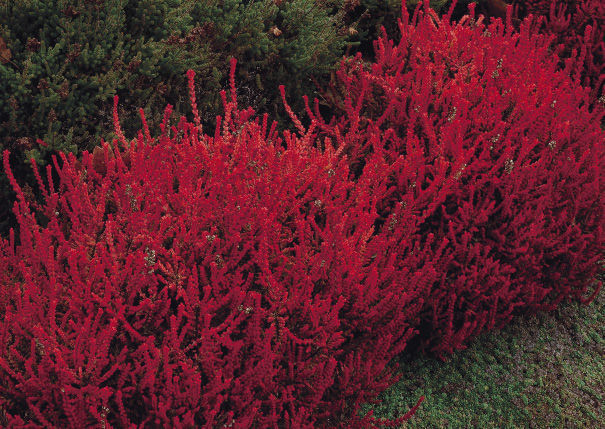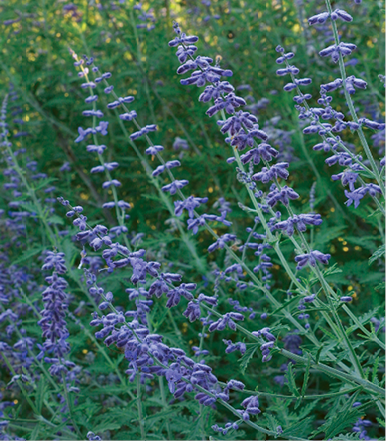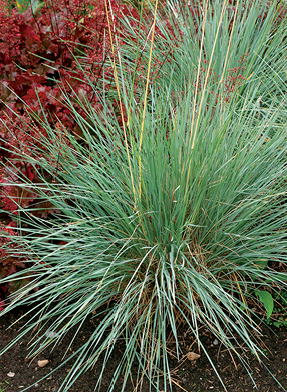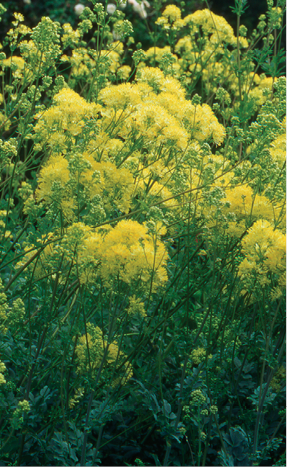

Russian sage
Name: Perovskia atriplicifolia
USDA Hardiness Zones: 6 to 9
Size: 3 to 5 feet tall and 2 to 3 feet wide
Conditions: Full sun; well-drained soil; tolerates drought
I have a love/hate relationship with Russian sage. I love its tall spikes of lavender-blue flowers, which provide a colorful backdrop for shorter perennials from late summer through autumn. I love its silvery gray foliage, which is too pungent for any deer’s delicate nose. Best of all, Russian sage requires no watering during long, dry summers once it is established. But let’s just say that when I tried to dig out my several-years-old plants that were threatening to overwhelm their less vigorous neighbors, I had a few choice things to say about their tenacious, spreading roots.

Blue oat grass
Name: Helictotrichon sempervirens
Zones: 4 to 9
Size: 3 feet tall and 2 feet wide
Conditions: Full sun; moist, well-drained soil; tolerates drought
Blue oat grass, with its long blades extending stiffly in all directions like the spines on a sea urchin, has architectural presence. But because it lacks lush, hostalike leaves, deer tend to avoid it. The first few years that I grew this grass, I was not enamored with its plumes. I thought the beige stems and flowers detracted from the form and color of the foliage, which stays blue all winter. As the plants have matured, however, I’ve changed my mind because the grass produces sturdier bloom stalks that have a graceful movement in the wind.

Dusty meadow rue
Name: Thalictrum flavum ssp. glaucum
Zones: 3 to 10
Size: 3 to 5 feet tall and 1 to 2 feet wide
Conditions: Full sun to partial shade; moist, rich soil
In early to midsummer, dusty meadow rue produces loads of fluffy, pastel yellow flowers that are borne on tall stalks above a mound of lacy, bluish green foliage. Some gardeners report that the flower stalks need staking, but they have never flopped in my full-sun garden. This meadow rue knows its place: It stays in one spot, returning faithfully year after year, never elbowing its neighbors aside or seeding all over the place. Although my deer relish other plants in the buttercup family, they have never eaten my dusty meadow rue.
‘Foya’ Scotch heather
Name: Calluna vulgaris ‘Foya’
Zones: 4 to 7
Size: 10 inches tall and 15 inches wide
Conditions: Full sun; moist, well-drained, rich, acidic soil
When ‘Foya’ flaunts its flaming orange-red foliage between October and April, even nongardeners ask me what it is. It helps that visitors approaching my house just happen to see the reddest side of the plants—the side facing due south. ‘Foya’ is one of a group of Scotch heathers whose golden summer foliage changes color with the combination of cool temperatures and strong sunlight, but it is more compact than most cultivars. Although stunning to humans, its bristlelike needles make it unappetizing to deer. Unlike some plants with golden foliage, mine have never shown a trace of scorching. Because the late-summer flowers are neither abundant nor showy, I usually don’t even notice when ‘Foya’ is in bloom, but its winter-foliage color is reason enough to plant it.
Photos: Jennifer Benner; courtesy of Barry Wulff; Jerry Pavia


















Comments
Log in or create an account to post a comment.
Sign up Log in